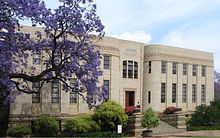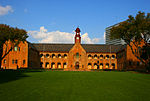- Merensky Library, University of Pretoria
-
Coordinates: 25°45′15.98″S 28°13′48.21″E / 25.7544389°S 28.2300583°E


Old Merensky Building (Pretoria) Contents
Historical background
In 1933 it was decided by the University to construct a separate building for the library which was then still located in the Old Arts building. With a contribution of £10 000 from mining geologist Dr Hans Merensky, construction started in 1937. General Jan Smuts laid the cornerstone on 11 October 1937 and on 15 April 1938 the building was officially opened.
“This country has given me so much that I am only too happy to be allowed to help it to develop and to be able to give back to it a fraction of what it has given to me...” - Hans Merensky, at the opening of the Merensky Library.
In designing the building, architect Gerard Moerdijk was influenced by various styles, including Art Deco, Neo-Classicism, Arts and Crafts, as well as local styles such as Cape Dutch and Regency. Moerdijk himself described the building as a study in Persian style, with influences from Africa including the Zimbabwe and ancient Egyptian ruins. He used local materials and incorporated symbols of African origin. The prominent zigzag pattern, for example, is taken from the Zimbabwe ruins and represents water and fertility, the crocodile as a water figure and the bird as a symbol of space, symbolizing the freedom and creativity of the author. The curving of the walls symbolises an open book. The green bevelled glass windows were imported from Italy and helped to minimise heat from the sun and also protected paper against ultraviolet light. The design of the building is a source of controversy and speculation with some claiming that Moerdijk used it as a practice run for the design of the Voortrekker Monument, as there are many similarities between the two buildings. Today this national monument serves as the Edoardo Villa Museum. The Edoardo Villa Museum currently houses the leading collection of sculptures by the Italian artist Eduardo Villa and one South Africa's most renowned sculptors, who was mentored by Minotti at the Scuola D’Arte Andrea Fontoniby.[1][2]
It also houses amongst others, a Mimi Coertse, Marita Napier and the largest South African sheet music collections.
Merensky II Library
Consisting of six levels, this building houses the UP Library Services Head Office; the Learning Centre; Technical Services and the faculty libraries for Humanities; Theology; Natural and Agricultural Sciences; Engineering, Built Environment and Information Technology; and, Economics and Management Sciences. It forms a focal point of the University's Hatfield Campus. The original library was initially housed in the Old Arts building before being relocated to the Old Merensky Library. Despite expansions to the Old Merensky Library in 1957, it soon became too small and the firm Lou, Marais, Marquard and Kuhn was appointed in 1969 to design a new library. Construction started in November 1971 and in August 1975 the building was completed. In the construction process the southern wing of the Old Chemistry building was demolished. Adjacent to the library there is a study centre that accommodates up to 1,230 students and is open seven days a week, 24 hours a day.
Centenary Tapestry
An interesting feature of the library is the spacious feel of the ground floor due to the three-level high ceiling in the central area. The wall of the mezzanine level is now adorned by an eye-catching panelled tapestry which was commissioned by the University in commemoration of its centenary celebrations in 2008. The idea was to create a work of art that would portray the University and which could be left as a legacy for future generations.
This tapestry was designed and embroidered by rural community members of the Kaross embroidery initiative in the Limpopo province. This embroidery initiative was established in 1989 by Irma van Rooyen, a BA Fine Arts graduate of the University and a recipient of the TuksAlumni Laureate Award. The conceptualisation of the tapestry and the execution of the design was done by Irma van Rooyen in collaboration with designer Calvin Mahlaule. Once the design was finalised, 15 embroiderers were employed to create the 15 x 1.2 meter tapestry. The work was executed on separate pieces of material using approximately 10 kg of yarn. The individual pieces of material were later appliqued and combined in a continuous process of layering the embroidered images and reworking them until the full length artwork was created.
This work of art reflects the culture, creative spirit and 'voice' of its makers and is a joyous manifestation of colour and craftsmanship!
References
- ^ http://tissuebank.co.za/default.asp?ipkCategoryID=10323&sub=1&parentid=5885&subid=10318&ipklookid=14 Edoardo Villa Museum. Retrieved 1 October 2009
- ^ http://www.artnet.com/Artists/ArtistHomePage.aspx?artist_id=24805&page_tab=Bio_and_links Edoardo Villa. Retrieved 1 October 2009
External links
- The Merensky Story (video)
- Old Merensky Library on UPSpace
- Merensky II Library on UPSpace
- University of Pretoria
- University of Pretoria, Library Services
- Gerard Moerdijk (Architect) Collection on UPSpace
University of Pretoria
Pretoria, South AfricaPeople Chancellor: Wiseman Nkuhlu · Vice-Chancellor: Cheryl de la Rey · Notable academics · Notable alumni 
Academics Theology · Humanities · Engineering, Built Environment and Information Technology · Law · Education · Veterinary Science · Health Sciences · Natural and Agricultural Sciences ·
Economic and Management SciencesBusiness School Knowledge Library · Special Collections · UPSpace · Merensky Library · Van Wouw Museum · Mapungubwe Museum · Van Gybland-Oosterhoff Collection · Van Tilburg CollectionMedical Facilities Kalafong Hospital · Onderstepoort Veterinary Academic Hospital · Steve Biko Hospital · Weskoppies Psychiatric Hospital
Sport University of Pretoria F.C. · FNB Varsity Cup
Student life  University · PeopleCategories:
University · PeopleCategories:- Academic libraries
- University of Pretoria buildings
- University of Pretoria library
- Monuments and memorials in South Africa
- Libraries in South Africa
Wikimedia Foundation. 2010.
